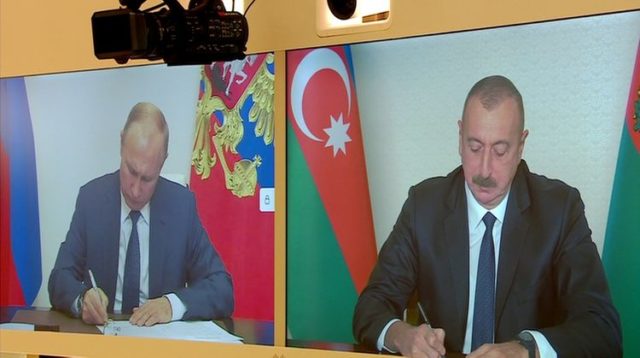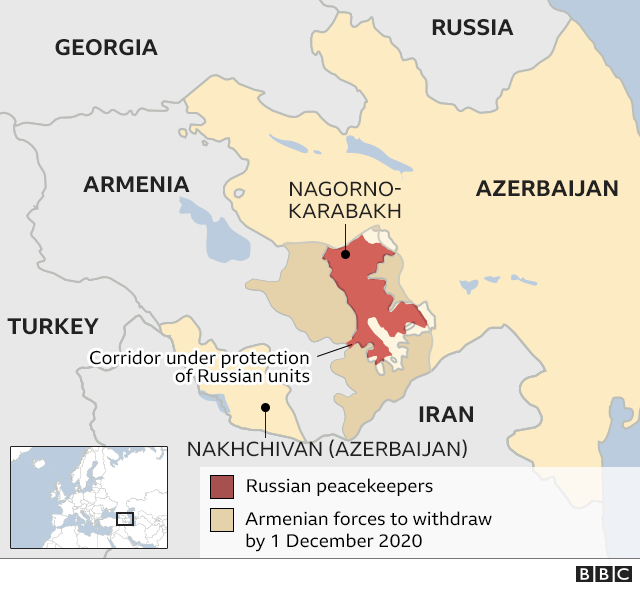
The New Truce in Karabakh: Implications for Azerbaijan and the Region
Publication: Eurasia Daily Monitor Volume: 17 Issue: 160
By:

Azerbaijan and Armenia signed a new ceasefire accord on November 10, finally halting the latest round of fierce fighting in Karabakh that had been raging for a month and a half. Armenian Prime Minister Nikol Pashinyan was the first leader to share this development, posting about it on his Facebook account (Facebook.com/nikol.pashinyan, November 10). This week’s agreement, in fact, marked the fourth ceasefire since the outbreak of violence along the Line of Control, on September 27. In each of the previous instances, the warring parties violated the ceasefires and instantly blamed each other. This time, the new document, signed by the leaders of Armenia, Azerbaijan and Russia, appears more likely to decrease tensions and ensure the two sides will stick to their obligations. However, the South Caucasus republics were forced to compromise by consenting to a stronger Russian presence in the region.

The trilateral document is significantly more detailed than the failed accord signed on October 9. Namely, it includes a well-defined schedule for the withdrawal of Armenian forces from Aghdam, Lachin and Kalbajar. At the same time, however, the document does not mention the future status of Karabakh. Proclaiming this as a diplomatic victory, Azerbaijani President Ilham Aliyev said that the issue of the status of the territory was intentionally kept out of the document and would not be up for debate for as long as he stayed in power. The well-known Turkish commentator Aydın Sezer predicted that Karabakh would preserve its autonomous status, as it had in Soviet times (YouTube, November 10). Although no referendum is mentioned in the current agreement, the leader of the Armenian community in Karabakh, Arayik Harutanyan, expressed his support for the trilateral statement, noting, “If the fighting had continued, we would have lost the whole of Artsakh [Armenian name for Karabakh] within a few days, and we would have had more victims” (YouTube, November 10).
The Russian-brokered document cements Moscow’s predominant position in the region. Russian soldiers left Azerbaijan in 2012, after the closure of the Gabala radar station (see Commentaries, December 14, 2012), but are now set to return to Azerbaijani territory as peacekeepers. This option was long rejected both by Armenia and Azerbaijan (Crisisgroup.org, December 20, 2019). Nonetheless, this time around, Russia managed to obtain the two parties’ approval to deploy forces, which look destined to stay in the region for at least the next five years. As such, Russia succeeded in strengthening its military position on the ground in the vicinity of regional “Silk Road” transit projects backed or promoted by China as well as the multi-billion-dollar energy infrastructure carrying Caspian-basin oil and natural gas to Europe—namely, the Baku–Tbilisi-Ceyhan (BTC) and South Caucasus pipelines.
Although Moscow had always emphasized the importance of the Minsk Group format for resolving the Karabakh conflict, the November 10 trilateral ceasefire statement notably does not refer to the Minsk co-chairs—the United States, France and Russia. Moscow brokered this latest deal while the presidential election has dominated the agenda in the US, and it has kept all other Western actors outside of discussions. However, Ankara now seems to be finding a place for itself in the equation. Namely, Aliyev stated that Turkish service members would be involved in monitoring the ceasefire and that Turkey would officially play a role in the future settlement of the conflict. Leyla Abdullayeva, the spokesperson for the Azerbaijani minister of foreign affairs, confirmed this, stating that although “no country’s name was [explicitly] mentioned […] Turkey will be part of the [Karabakh peacekeeping] control-and-monitoring center with Russia” (Yenisafak, November 11).
Moscow State Institute of International Relations (MGIMO) expert Maxim Suchkov argued last month that he did not believe Russia would be willing to raise Turkey’s influence in the Caucasus. Though he acknowledged this could change depending on developments on the ground (Author’s interview, October 1). Indeed, on October 14, Russia’s Foreign Minister Sergei Lavrov gave a radio interview in which he expressed Russian discomfort over Turkey’s position in the conflict despite the country being a close partner—though not a strategic ally—of Moscow (Mid.ru, October 14). Nevertheless, a few weeks later, President Vladimir Putin called for Turkish involvement in Karabakh as the warring parties continued to violate their ceasefire agreements (The Armenian Weekly, November 2). Now, Russian officials have begun hinting that Turkish personnel could soon be deployed to Azerbaijani territory (Interfax, November 10).
Turkey has steadfastly backed Azerbaijan from the beginning of the latest clashes, both in military and diplomatic terms. As such, Aliyev repeatedly expressed Azerbaijan’s wish to bring Turkey into any discussions of a final political solution to the Karabakh conflict. That said, the expected arrival of Turkish peacekeepers in Azerbaijan goes beyond those calls. The presence of Turkish service members may reflect Azerbaijan’s attempt to balance against Russia. But for now, Ankara has not delivered any official statement regarding the details of such a deployment. Still, Ankara is staying in close contact throughout this process with both Moscow and Baku. Turkish President Recep Tayyip Erdoğan spoke by phone with Putin on November 10 and discussed the developments in the South Caucasus and Syria (Kremlin.ru, November 10). At the same time, a Turkish delegation composed of the ministers of defense and foreign affairs, head of intelligence and commander of the Land Forces visited Baku to meet with President Aliyev (Azertag, November 10).
Russia is moving swiftly to send its troops to the region following the truce. Its soldiers will keep open the Lachin corridor linking Karabakh and Armenia as well as replace Armenian forces along the Line of Contact as the latter withdraw. Moreover, Russia’s Federal Security Service (FSB) will oversee the transport connections between Nakhchivan and mainland Azerbaijan.
The main risks that lie ahead will surely relate to the actual withdrawal of Armenian forces from the occupied territories. Even though the November 10 accord suggests that the peacemaking center will monitor both parties’ fulfillment of the agreements, the document does not specify a specific enforcement mechanism. Whether Armenia abides by the given schedule will remain a critical question for the next few weeks.
The resulting political turbulence in Armenia illustrates that Pashinyan’s control over the country was more fragile than it may have appeared (Daily Sabah, November 10). From the Kremlin’s perspective, this is not a loss and may, in fact, be seen as a political gain (see EDM, October 8, 29). Pashinyan came to power in a triumphant “Velvet Revolution”; but now his political career is in danger. Yet Baku understands that his future is also linked to the fulfillment of the November 10 agreement, thus putting the durability of the truce in question.



